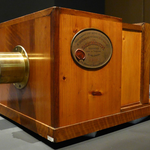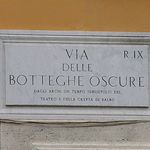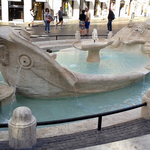Pantheon
It is one of the majestic and magnificent buildings in ancient Rome that reached us as the best preserved.
For his exceptional size, for the particular character of its planimetry (The building has a circular plan united to the pronao of a greek kind.) for his harmony and the constructive wisdom because of which the dome had been turned it can be considered as the most important example of constructive technique of the Roman architecture.
Popularly it is known as La Rotonda, from which the nearby square takes the name.
It was built in 27 B.C. by Marcus Vispanius Agrippa, Augustus' general during its third consulate as the Latin inscription states in the pediment, "M. Agrippa L. f. cos. III Fecit" (belonging the Hadrian reconstruction) of which the traces remained in the Field of Mars in the vicinity of the thermal bath you build from him.
It was dedicated to seven planetary divinities from which the greek name Pantheon comes, di tutti gli dei of all the gods.
We know from Plinium than the building was decorated in the time by athenian Diogene. His caryatids in the porch and the sculptures of the pediment were admired. The columns had bronze capitals.
Destroyed by the fire of 80 A.C. it was restored by Domition.
Later it was struck by the lightning in 110 under Trajan and together with other edifices from Field of Mars (118-125) it was completely rebuilt again by Hadrian, then it was restored by Severe Settimius in 202 and subsequently by Caracalla, as the inscription in small letters under the Agrippa's one says.
Closed by first Christian emperors, sacked by the barbarians it was presented by the emperor Foca to the pope Bonifacio IV who devoted it (609) to Madonna and all the martyrs (Santa Maria and Martyrs). Released from the gilt bronze tiles by the emperor Constantine II of the East (663) it acquired a lead roof under Gregorio III (735).
During the Middle Ages it was considered to be one of the jewels and the symbols of the city and however sometimes it was used as a fort in the town struggles.
At the beginning of the Renaissance it underwent quite a lot of restorations and spoliations: under Alexander VII Bernini put up two bell towers on the pronaos called"donkeys' ears" demolished in 1883.
Urban VIII Barberini took away the bronze truss from the porch to let Bernini do the canopy of San Pietro and he ordered to build guns for Castel Sant' Angelo of the remained bronze. Regarding this Pasquino said "Quod not barbarian Fecerunt, Fecerunt Barberini" (What the barbarians didn't do, the Barberinis did).
The current structures belong to Hadrian's as approved by the stamps on the bricks of his masonry. The masonry is proceeded by the pronao measured by 16 monolithic pink Corinthian columns of grey and rose granite with bases and capitals of marble. It supports the triangular pediment.
The sensation of monumental simplicity that one feels inside is due to the fact that the height is equal to the diameter: it is a perfect sphere inserted in a cylinder as high as its radious.
All this done gives a sense of the extraordinary architectural balance.
The structure in bricks of the Rotonda always gets lighter from down towards the cupola and it is 43,30 metres high same as a diemeter and the dome is the largest in the world ever created in masonry.
A the center of the dome there is an opening measured of 8 in 92 meters. It is the so-called occhio the "eye", which lights up all the interior.
For its fulfilment the traditional methods were not possible. So Hadrian made the interior of the temple to be filled with earth mixed with golden coins upon its building. As the dome had been built he told the people to take out the earth and that the found coins could be brought away.
In the twinkling of an eye in 1668 the temple was emptied from the earth and the dome was hung up.
Clement IX surrounded the Pronao with an iron gate (which was dismantled after the unity of Italy) to avoid the square in front of the market invading also the cult place.
Pious IX continued the restorations (the floor was renewed) and the isolation jobs were continued together with other excavations by the Italian government.
In 1500 Rphael began the tradition to bury the great artists in the Pantheon among which is Raphael himself. In spite of the fact that Raphael tomb is present it is not sure if there are his bones in the sarcophagus. In 1833 Pope Gregorius XVI made them to be searched and a skeleton found in a niche was attributed to Raphael. In 1500 on the sarcophagus the famous lines of the poet Pietro Bembo were carved in Latino that start with "Here lies Raphael".
Later it became a memorial chapel of all the kings. Vittorio Emanuele II, Umberto I and the Queen Margherita were buried here.
Vittorio Emanuele III and Umberto II who died in exile in 1947 and in 1983. They were not buried in the Pantheon.
Actually the Roman Curia has transformed the monument into Catholic basilica open to the cult.

 The records of Rome. Big numbers, not always enviable, for a big city.
The records of Rome. Big numbers, not always enviable, for a big city. New Phot-O-Matic section. To spend some time looking at photos (also) of Rome.
New Phot-O-Matic section. To spend some time looking at photos (also) of Rome. The administrative, urban, toponymic and imaginative subdivisions of Rome.
The administrative, urban, toponymic and imaginative subdivisions of Rome. Notice for tourists: in Rome you drink for free. Historical fountains and 'big noses'.
Notice for tourists: in Rome you drink for free. Historical fountains and 'big noses'. Free museums return on the first Sunday of the month.
Free museums return on the first Sunday of the month.